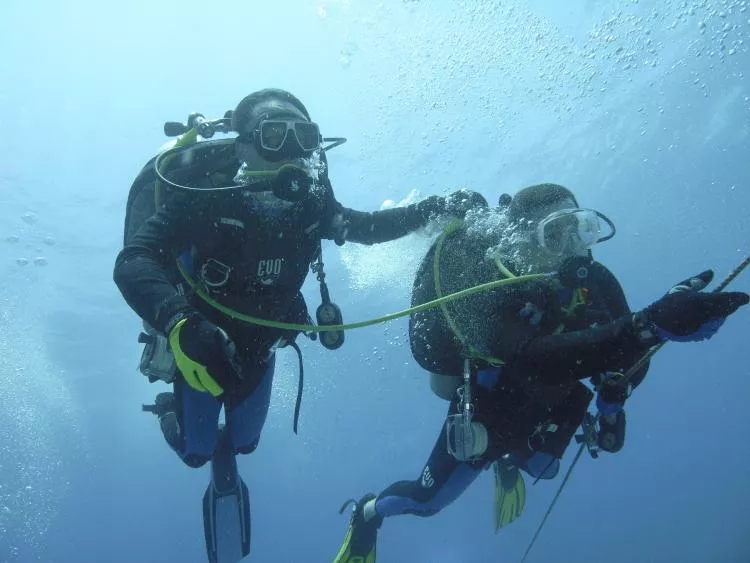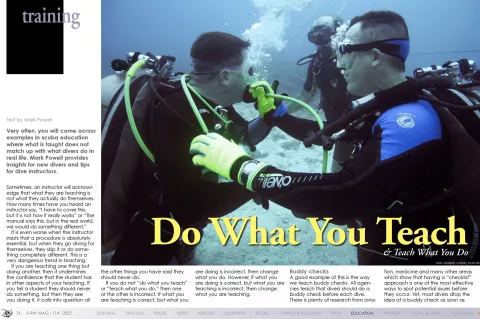Very often, you will come across examples in scuba education where what is taught does not match up with what divers do in real life. Mark Powell provides insights for new divers and tips for dive instructors.
Contributed by
Sometimes, an instructor will acknowledge that what they are teaching is not what they actually do themselves. How many times have you heard an instructor say, “I have to cover this, but it is not how it really works” or “The manual says this, but in the real world, we would do something different.”
It is even worse when the instructor insists that a procedure is absolutely essential, but when they go diving for themselves, they skip it or do something completely different. This is a very dangerous trend in teaching.
If you are teaching one thing but doing another, then it undermines the confidence that the student has in other aspects of your teaching. If you tell a student they should never do something, but then they see you doing it, it calls into question all the other things you have said they should never do.
If you do not “do what you teach” or “teach what you do,” then one or the other is incorrect. If what you are teaching is correct, but what you are doing is incorrect, then change what you do. However, if what you are doing is correct, but what you are teaching is incorrect, then change what you are teaching.
Buddy checks
A good example of this is the way we teach buddy checks. All agencies teach that divers should do a buddy check before each dive. There is plenty of research from aviation, medicine and many other areas which show that having a “checklist” approach is one of the most effective ways to spot potential issues before they occur. Yet, most divers drop the idea of a buddy check as soon as they finish their training.
One of the reasons for this is that most instructors do not perform a buddy check when they are diving, and even if they do a buddy check, it is very different to the one they teach. They do not “teach what they do” or “do what they teach.”
This leads to the situation where a buddy check is seen as something that is only done in training or is only done by inexperienced divers. This completely defeats the objective of teaching a buddy check.
Everyone should do a buddy check before each dive. As you become more experienced, you may get complacent and forget a basic step, so buddy checks are still essential for the most experienced diver.
The problem is that we do not teach “realistic” buddy checks. We do not teach what we do. Some agencies insist on a rigid buddy check in order to help the student remember the process. Unfortunately, this leads to a rigid, formulaic approach that is not realistic.
Real-world examples
I remember one instance where I was teaching a Course Director course, and an aspiring course director, enrolled in the course, started to demonstrate a buddy check. This aspiring course director was an experienced diver and instructor as well as a very experienced technical instructor. I had seen him do plenty of effective, realistic buddy checks in the past. However, as soon as he started demonstrating the buddy check, he turned into a robot, going through a very rigid and unrealistic process that I had never seen him do in real life.
Afterwards, I asked him why he had demonstrated it that way and he said, “I thought that was how we were supposed to teach it.” He recognised all the disadvantages of teaching it that way, understood that it was not effective, and agreed that it caused divers to drop the practice as soon as they finished their course, but thought he had to do it that way anyway.
The other disadvantage of this approach is that it focuses on the procedure rather than on the intended result. The intended result of a buddy check is, of course, to spot any potential problems. Divers and their buddies are so focused on following the procedure that they often do not spot obvious problems.
Real-world examples of this, which I have seen, include a diver saying, “My drysuit inflator is here and is working,” when the hose is not even attached. I have seen divers point to their BCD belt buckle while saying, “This is my weight belt.” I have also seen divers doing what appeared to be a perfect buddy check without them or their buddies realising that their air was not turned on. Finally, I have seen divers complete a buddy check, turn around and jump into the water without either them or their buddy noticing that their drysuits were open, or in one case, that they were not wearing any fins. They completed the procedure but completely failed to achieve the objective.
A different approach
One technique I use when teaching is to think of a buddy check as a game. Assume your buddy has made a mistake with his or her equipment, and your challenge is to find it. It can become quite competitive, with divers being extremely careful to check their own equipment before the buddy check to make absolutely sure that there is nothing for their buddies to pick up on, while the buddies look at every bit of kit with eagle eyes in the hope of finding some mistake that has been overlooked.
This has the advantage of building the right mindset in both divers. You end up with divers who are very careful about putting together their own kit and doing a buddy check on themselves, but you also develop divers who are constantly looking at other divers’ kit and will often identify problems in divers other than their buddies.
I also show students how I would do a buddy check in the real world, and how I would deal with the real-life challenges. For example, what if you are buddied with a diver that trained with a different agency and uses a different acronym? I am lucky to have trained with a number of different agencies and dived with divers from even more, so I have come across ABCDE, BAR, BWRAF, SEABAG and many other approaches to doing a buddy check.
It would be great if we all had the same way of doing a buddy check, but this is not the case. I am happy to follow the process or abbreviation that other divers prefer, if that makes it easier for them, as most of the approaches cover the main points. I also add in my own final sanity check of considering what has not been checked, and finally giving the diver a thorough look from head to foot, to spot anything that just does not look right.
But what if you are on a boat and cannot stand right in front of your buddy to do the buddy check? Many divers are taught to pick up the components of their buddy’s kit and physically test it. This is fine when you are in close contact, but what if you are on the other side of the boat? In addition, some divers do not like other divers touching their equipment and are not comfortable with this approach. I do not mind who is checking the equipment as long as I am confident that it has been checked.
By adopting this approach, I have found that divers are much more likely to perform a buddy check and are happy doing it with divers from different agencies. It also means that if I am diving with any of my students, they see me doing what I taught them.
Solo diving
Another good example of “do what you teach” and “teach what you do”—or rather, a good example of breaking this approach—is solo diving. For years, instructors have taught that solo diving is bad and should not be done under any circumstances. Then, on their days off, they have gone solo diving; divemasters on dive boats have dived down on their own to tie in a line or release a line; instructors are told that it would be unsafe to dive alone, but they can take in a student on their first dive, and that is perfectly safe.
If instructors, divemasters and experienced divers are doing this on a regular basis in private, why do those same divers insist it is unsafe in public? Despite teaching one thing, they are clearly doing another. This is hypocritical and does not meet the “do-what-you-teach” and “teach-what-you-do” approach.
If instructors genuinely believe that it is acceptable for them to solo dive, then they must stop telling their students that it is unacceptable. Rather, they should be teaching that solo diving has a number of risks, but these risks can be mitigated by an experienced diver with the right experience, training and equipment.
On the other hand, there may well be instructors that do believe that solo diving is not safe and teach that divers should always dive in the buddy system. In this case, those instructors need to specify that diving in the buddy system is more than just diving with a random buddy. A buddy should be able to assist you in an emergency, have a similar dive plan, and have similar equipment configuration.
Teaching tables and using them
How many instructors teach tables during their open water course? How many use tables themselves? If they are teaching tables but not using them, this is not a good example of “doing what you teach” and “teaching what you do.” So, why do many instructors still insist on teaching tables even if they do not use them themselves?
Many diver-training courses can trace their origins back to the ‘60s, ‘70s and ‘80s when dive computers were not available to the average recreational diver, and dive tables were the only options. As a result, courses included how to plan your dive using tables.
Even during the late ‘80s and ‘90s, when dive computers started to trickle into the recreational diver market, the computers were not that reliable, and so dive tables were still the preferred option. However, since the mid ‘90s, personal dive computers have become much more reliable and have become almost universal. Despite this, diver training is still focused on teaching dive tables.
This causes a number of issues. First, using the tables are a moderately complicated process, and it can confuse some students, especially if the instructors themselves do not use the tables and give a weak explanation. Secondly, most divers do not regularly use their tables, and so quickly forget how to use them.
The biggest issue though, is that with dive computers becoming more affordable, reliable and popular, it has become normal for divers to buy a dive computer as one of the first bits of dive equipment they buy. So, they would be taught to use tables but then immediately switch to using a computer. This means that we have a situation where the instructor says divers must use tables, but they only have a brief introduction to the tables and do not use them frequently, so the students quickly forget how to use them. At the same time, they have bought a nice dive computer, but they do not know how to use it, and so misuse the computer.
If the instructor does not use dive tables to plan their dives, why should they insist that the students plan their dives using tables? If they use computers to plan and execute their dives, then they should be teaching their students how to safely plan and execute their dives using a computer.
Deco tables and dive computers
Some instructors insist that divers should understand decompression tables before they can use a dive computer, so that they understand the principles behind how the computer works. This has two problems: The first is that dive students do not understand it—most divers do not leave their training with a good understanding of how tables work; and the second is that even if dive students understand how to use the tables, it does not mean that they understand the underlying concepts or can apply them to dive computers.
It would be better to save the time that is taken in teaching how to use the tables, and instead, use that time to teach the basics of decompression theory, and most importantly, how to plan and execute a dive using a dive computer.
If you are an instructor, I would encourage you to think about what you are teaching and ask yourself, “Is this what I actually do?” If there is a mismatch, ask yourself, “Is what I am teaching wrong, or is what I am doing wrong?” Then, do something about it.
If what you are teaching is wrong, then change what you are teaching. If what you are doing is wrong, then change what you are doing. As instructors, we are role models and have a huge impact on the divers we teach.
Teaching students to do the wrong thing, or doing the wrong thing ourselves, and by implication, teaching them that they can ignore the safety rules, can have huge consequences on dive safety. As role models, we need to be setting the example, and encourage the right behaviour at all times, rather than sabotaging it.





























